3-2
Freezer Temperature Control —
Temperature Decreasing
When the freezer temperature begins to de-
crease, the process will reverse. The compres-
sor speed decreases, followed by the evapo-
rator fan speed.
Refrigerator Temperature Control —
Temperature Increasing
When the refrigerator calls for cooling while
the freezer is satisfied, the air door begins to
open, and the evaporator fan starts to run at
minimum speed. If the temperature continues
to rise, the air door will continue to open. If the
temperature continues to rise after the air door
is fully open, the evaporator fan speed will
gradually increase to a maximum of 3000 rpm.
If the temperature continues to rise, the com-
pressor starts to run, or if it has already been
running, begins to increase in speed.
Refrigerator Temperature Control —
Temperature Decreasing
As the refrigerator temperature approaches the
selected setting, the control compares the tem-
peratures in both compartments to determine
which compartment will control the fan speed.
If the freezer is further from the selected tem-
perature setting, it controls the fan speed, and
the air door begins to close, thus reducing the
airflow to the refrigerator.
If the freezer is satisfied, the air door remains
open, and the fan speed begins to decrease.
When the selected temperature setting is
reached, the air door closes.
TEMPERATURE CONTROL
The electronic control checks the resistance of
the thermistors, and compares it to both the
customer temperature settings and the last
thermistor reading taken. This information is
used to determine when to begin a cooling
operation, and if a change is necessary in the
damper setting, or the evaporator fan or com-
pressor speed.
When a warm refrigerator is first put into a
cooling mode, the air door partially opens, and
the compressor and evaporator fan motors
start to run at maximum rpm. The air door will
gradually move to its fully open position.
As the actual temperature in the refrigerator
nears the selected temperature setting, the
electronic control compares the temperatures
in both compartments. The compartment that
has the greatest need for cooling, will control
the speed of the evaporator fan motor.
Freezer Temperature Control —
Temperature Increasing
When the freezer calls for cooling, the com-
pressor begins to run at minimum rpm, (see the
chart on page 3-3), and the evaporator fan
begins to run at 2000 rpm. The compressor
and evaporator speeds are continuously up-
dated. Speed changes are made based on:
• The difference between the actual tempera-
ture and the selected temperature settings.
• The rate of temperature change.
If the temperature increases 4°F above the
selected temperature setting, the evaporator
fan speed begins to gradually increase. The
evaporator fan motor reaches the maximum
speed of 3000 rpm at 5°F above the selected
temperature setting, and the compressor speed
begins to gradually increase. A maximum com-
pressor speed of 4500 rpm will be reached at
9°F above the selected temperature setting.


















